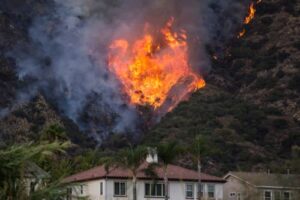
Homeowners insurance covers damage caused by wildfires up to the policy’s limits. As the wildfire risk increases in some parts of the U.S., home insurance is becoming expensive and harder to find.
Last updated: Jul 31, 2024 Compare quotes in less than 5 minutes
Written by Mel Duvall
Contributing ResearcherMel Duvall is an award-winning senior business writer and communications professional. He has written for a variety of newspapers and magazines including The Financial Post, Inter@ctive Week, Baseline Magazine and American Banker. He also served as Senior Media Manager for Husky Energy, a fully integrated energy company with operations in Canada, the United States, China and Indonesia.

Reviewed by Leslie Kasperowicz
Leslie Kasperowicz is an insurance expert with four years of direct agency experience and over a decade of creating educational content to help insurance shoppers make confident, informed decisions.
Fact checkedAt Insurance.com, we are committed to providing the timely, accurate and expert information consumers need to make smart insurance decisions. All our content is written and reviewed by industry professionals and insurance experts. Our team carefully vets our rate data to ensure we only provide reliable and up-to-date insurance pricing. We follow the highest editorial standards. Our content is based solely on objective research and data gathering. We maintain strict editorial independence to ensure unbiased coverage of the insurance industry.

In the first three years of this decade, wildfires burned more than three times as much forest as an average year in the 1980s, according to the National Interagency Fire Center.
With the rise in wildfires, so, too, are the number of questions homeowners might have about wildfire insurance coverage. Does homeowners insurance cover wildfires? What about a condo or rental? Do you have enough insurance to rebuild? What should you do if you can’t get coverage?
Homeowners insurance does cover wildfires, but in some areas, coverage is hard to find.
Insurance companies are facing huge losses in wildfire claims and in many cases are passing the costs along to homeowners in the form of rate increase. In the most extreme cases, insurers – including some of the industry’s biggest names – no longer offer new policies to property owners in the highest-risk areas.
California is currently experiencing this crisis with at least two major insurers, State Farm and Allstate, saying they will no longer issue new homeowners policies in the state.
“It’s causing panic and anger … lots and lots of anger,” says Dori Einhorn, owner of Einhorn Insurance in San Diego, Calif. “When State Farm left, it caused a domino effect with other carriers pulling out or non-renewing policies. It’s left people with an increasing lack of options.”
Here, we’ll cover how home insurance covers wildfire damage and how to ensure you’re properly insured.
Yes, insurance covers wildfire damage. Fire is one of the main perils covered by a home insurance policy, and car insurance will also cover fire damage as long as you carry the right coverage. Wildfire insurance coverage for your car falls under the comprehensive portion of your policy.
Home insurance covers fires as part of a standard policy. That includes wildfires.
A standard homeowners policy covers damage caused by fire, including wildfires. In the event of a fire, your insurance company will pay to rebuild or repair your home and remediate smoke damage. This will include outbuildings on your property, such as a garage or tool shed.
The amount paid out by your policy for a wildfire insurance claim is determined by the terms and limits of your policy. If you’ve made substantial improvements to the house, made additions or other renovations that increased the replacement cost of your home, discuss that with your insurance carrier to make sure the improvements are covered.
Standard condo insurance covers fire damage, including wildfires.
Here’s where it gets complicated. Because co-op and condominium owners share building structures and amenities, two policies are required to fully protect all parties.
The master policy: This is the policy that protects the entire structure. The building management is responsible for it and the premiums generally come from your condo fee or association dues.
The master policy covers common areas you share with other owners and equipment associated with the building such as elevators, boilers, walkways and garage structures.
Condo master policies can range from one that requires the building to be rebuilt to its original specifications, including standard fixtures, including those initially installed in your unit. In not-as-comprehensive master policies, insurance may only be responsible for repairing or rebuilding the structure, such as the bare walls, floors and ceilings. In the event of a disaster, the condo owner is responsible for elements like kitchen cabinets, built-in appliances, bathroom fixtures, etc.
It is best to determine the extent of coverage provided by your condo’s master policy to determine the amount of additional coverage needed.
The individual policy: This is the policy that covers the furnishings, fixtures, appliances, plumbing and personal belongings in your own unit that are not covered by the master policy.
Everything that is covered by the policy is covered for fire and smoke damage, up to the policy limits. Like a home insurance policy, you will also have coverage for additional living expenses if a wildfire forces you to live elsewhere for a time.
Like condo insurance, renters insurance will cover your personal belongings if they are lost or damaged in the case of a fire, including wildfires. If the home or rental unit you’re living in becomes uninhabitable due to the fire, or you are forced to evacuate, your loss of use coverage may pay for you to stay at a nearby hotel, but this is something you need to check.
Your personal rental insurance will not cover physical damages to the main building structure due to a wildfire, similar to condo insurance – that would fall under the apartment building or dwelling’s master policy.
A standard homeowners policy will insure your belongings for loss or damage. It will also provide compensation to pay for shrubs or trees lost as well.
In addition, your policy will also pay for theft or vandalism in the wake of a fire, which may take place if you are unable to live in it while repairs are underway.
The main coverages on your home insurance for a fire are:
Dwelling coverage. This covers damage to the dwelling itself and any attached structures, like a deck or attached garage, up to the policy limits. Dwelling coverage is based on the replacement cost of your home.
Other structures. This is a percentage of your dwelling coverage and covers any structures not attached to the home, like a shed.
Personal property. This covers all your belongings, from the TV to the towels, and is a percentage of the dwelling coverage. The Insurance Information Institute (III) notes that it’s always a good idea to keep an up-to-date home inventory and copies of important papers offsite (for example in a safe deposit box), so you won’t lose them in a fire.
Personal property coverage is not automatically at replacement cost in a standard policy, which means you’re only covered for actual cash value. You can add replacement cost as an endorsement to be covered for replacement with brand-new items.
Additional living expenses (ALE). ALE covers expenses incurred when you can’t live in your home due to a covered loss, such as:
ALE will also kick in if a wildfire forces you from your home due to mandatory evacuation (but not if you choose to leave.)
As discussed earlier, fires, including wildfires, are covered under standard homeowners insurance policies. However, if you do live in an area that is at higher risk of wildfires, you may want to consider increasing the amount of your extended replacement cost coverage.
Keep in mind, this may not come cheap. If the insurance carrier does a deeper dive into such factors as your location, whether nearby brush or heavily treed areas are a concern, or if there’s been an increasing pattern of wildfires in your area, they may ask for steep premium increases.
In some areas, insurance companies are moving to remove fire coverage from a standard policy, in which case homeowners will need to find that coverage elsewhere. If you live in a high-risk area, make sure you read your insurance renewal offer carefully.
Extended replacement cost coverage acts like a buffer to help safeguard against cost overruns. It essentially extends your policy coverage, so you can rebuild the home you love, down to the upgrades and renovations.
Here’s how it works:
“This type of coverage is widely available and highly recommended by insurers, especially if you live in an area prone to large-scale natural disasters,” says Karen Collins, assistant vice president for the American Casualty Insurance Association (APCIA), a national trade association for home, auto and business insurers.
Some companies also offer guaranteed replacement cost coverage, which guarantees that your home will be replaced regardless of the increase in replacement cost over time.
Most carriers that are no longer insuring homes in high-risk areas, say they are no longer taking on new policies – they will not drop existing policyholders. That is the case, for example, with Allstate and State Farm in California.
However, many customers in high-risk areas are seeing nonrenewal notices from their insurers.
The general trend for carriers to limit their insurance coverage in high-risk areas is troubling for home and business owners, says Rex Fraser, president of the Personal Insurance Federation of California. While he is concerned about the impact on individual policyholders, he does understand the tough business decisions some insurers are having to make and says it may require underlying changes to how the industry is regulated in California.
At the moment California rate rules require wildfire risk to be priced based upon an insurer’s average wildfire losses during the past 20 years. The problem is, as the National Interagency Fire Center has documented, the number and intensity of wildfires have dramatically increased in recent years. As a result, insurers have not been able to increase premiums enough in high-risk areas to cover their losses.
“If California rules were updated to match what every other state does with reinsurance and future-looking models, we would be in much better shape,” Frazier says. This change is in progress.
At one time, Einhorn would have recommended that policyholders who have been dropped by their carriers or experienced steep premiums hikes shop around for better rates. These days she’s changed her tune – particularly for those in high-risk areas.
“I’ve had to be very frank with people. I tell them to stick with their current carrier – stay put,” she says. “I’ve had clients see their rates go from $1,800 a year to as much as $10,000 a year. Naturally, people can’t understand it.”
At the same time though, she says to be sure that you’ve explored all avenues for getting bigger discounts, such as getting multiple forms of insurance with the provider of your home insurance.
Wildfires are becoming an increasing risk in many more areas of the country.
According to the National Interagency Fire Center, California leads the nation in terms of acres burned in recent years.
In any given year, a state like Texas or Colorado can have a bad year, but in general, it’s California’s neighboring states of Oregon, Montana, Washington and Arizona, that are the second- to fifth-highest for risk of wildfires.
Property owners in California and other states that are experiencing insurance crises brought on by natural disasters have had to increasingly turn to state insurers of last resort. Each state has its own plan.
For example, while it does provide protection against loss due to wildfire, coverage under the California Fair Plan is generally more expensive than what can be obtained in the general market. It also has more limitations and will only provide up to $3,000,000 in coverage.
The insurance federation’s Frazier says there are real concerns the FAIR Plan could run out of money in the event of a major disaster requiring the industry, which backstops the plan, to come up with additional funds.
He says that could create an unvirtuous cycle where more insurers pull out of the market to further limit their exposure to risk.
In some cases, you can’t prevent being impacted by a wildfire. You may simply be in the path of flames driven by wind and fuel.
However, there are some simple steps you can take to limit the risk and ensure you do not add additional fuel to the infernal. The following tips are offered by the III’s home and safety division.
If you live in California, you can earn wildfire mitigation discounts on your home insurance for some of these upgrades.
Not surprisingly, most wildfires are human caused. According to the U.S. Forest Service Research Data Archive, nearly 85% of wildfires in the U.S. are started by humans.
This includes campfires being left unattended or improperly extinguished, the burning of debris, fireworks, negligently discarded cigarettes and intentional acts of arson.
Lightning strikes are the next most common cause of wildfires and in a fairly distant third is volcanic activity.
Although there are some places where wildfires are a much higher risk, they can and do happen just about anywhere. Home insurance covers damage caused by wildfires, but it’s vital to make sure you have enough coverage on your policy.
Take the time to review your policy with your agent or a representative from your insurance company so that you can be assured your replacement cost is up to date and you’ve added any endorsements, like extended replacement cost or replacement cost coverage for personal property, that you need.
Although home insurance rates in wildfire-prone areas are going up, cutting coverage to save will leave you underinsured. Instead, shop around, compare rates and get expert advice to get the coverage you need at the lowest price.
A fire damage claim is likely to result in a rate increase on your next renewal, as your house is now considered a higher risk. Additionally, even if you don’t file a claim yourself, if there are a lot of fire claims filed in your area, rates may go up for all homeowners in that area due to the risk.
There’s no additional cost on top of your home insurance premium to be insured against wildfires. However, you might pay more in general in a wildfire-prone area or if you add additional coverage like extended replacement cost.
Yes, if you have comprehensive coverage on your policy. Comprehensive covers most non-collision damage to your car, including fire damage.
Sources: